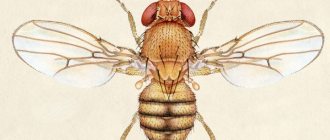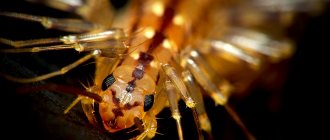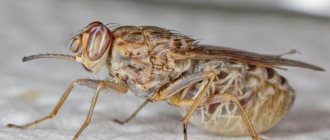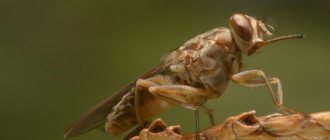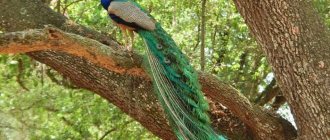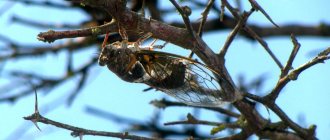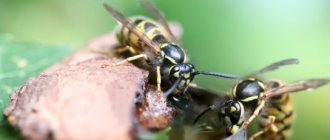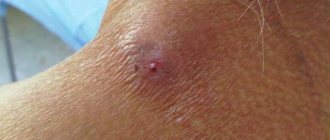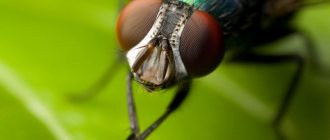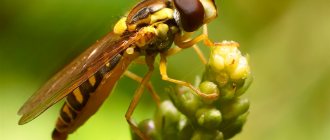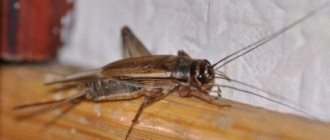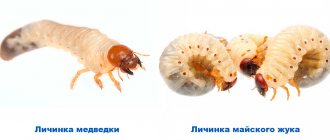- Wild animals
- >>
- Insects
There are a huge number of different insects in the world. One of the most famous and widespread is the Drosophila fly . These tiny flies are familiar to absolutely everyone. You don’t have to wait long for their appearance if there is a bitten or slightly rotten fruit in the house. Even a few days are enough for a whole swarm of fruit flies to appear over a half-eaten peach or apple.
Origin of the species and description
Photo: Drosophila fly
The Drosophila fly can appear in any home, and in vegetable or fruit warehouses and stores it is a permanent resident. This animal is familiar to any gardener and gardener. This fly is quite annoying and extremely difficult to get rid of. Despite this, fruit flies are highly valued by scientists. They are unique scientific material. Today various experiments and scientific experiments are carried out on this animal.
Video: Drosophila fly
The Drosophila fly is called differently: Drosophila minor, fruit fly, fruit midge, Drosophila vulgaris. In Latin the name sounds like Drosophila melanogaster. This is an insect with two wings, a type of midge belonging to the genus Drosophila. Drosophila belongs to a large family of fruit flies.
Interesting fact: Drosophila has many different names and nicknames. People call these insects wine or vinegar flies. This is due to the fact that they very quickly detect the source of the sour fruity smell. Therefore, there are many such animals in various factories and plants for the production of juices and wine.
Today there are quite a few varieties of fruit flies. Scientists count more than a thousand species. Most species live in subtropical and tropical climates. In particular, more than three hundred species of such insects live on the Hawaiian Islands alone. On the territory of the Russian Federation, the most common type of fly is the flightless Drosophila.
The Drosophila fly is characterized by the following features:
- a diet consisting of fermented products;
- high sensitivity to sour aromas;
- fertility - one female is capable of laying several hundred eggs throughout her life;
- the presence of obvious visual differences between females and males.
Taxonomy
| Samoa | |
| Liodrosophila | |
| Hirtodrosophila | |
| Paramycodrosophila | |
| virilis-repleta radiation (partially) | |
| Scaptomysa | |
species group
Dorsilofa| Lordiphosa | |
| Hirtodrosophila duncani | |
D. setosimentum
, a species of Hawaiian winged fly
In the genus Drosophila
it is currently defined as paraphyletic (see below) and contains 1,450 described species,[3][42] and the total number of species is in the thousands.[43]
Most species are members of two subgenera: Drosophila
(about 1,100 species) and
Sophophora
(including
D. (S.) melanogaster
; about 330 species).
Hawaiian Drosophila
(estimated to be over 500, of which approximately 380 species are described), are sometimes recognized as a separate genus or subgenus,
Idiomy
,[3][44] but this is not generally accepted.
About 250 species are included in the genus Scaptomysa
, which originated from the Hawaiian
Drosophila
and later recolonized continental areas.
Evidence from phylogenetic studies suggests that these genera are descended from the genus Drosophila
:[45][46]
- Liodrosophila
Duda, 1922 - Mycodrosophila
Oldenburg, 1914 - Samoa
Malloch, 1934 - Scaptomysa
Hardy, 1849 - Zaprion
Coquillette, 1901 - Zygotrica
Wiedemann, 1830 - Hirtodrosophila
Duda, 1923 (position undetermined)
Some of the subgeneric and generic names are based on anagrams of Drosophila
, including
Dorsilophus
,
Lordiphosa
,
Syphlodorus
,
Floridosa
, and
Psilodorchus
.
Appearance and features
Photo: What a Drosophila fly looks like
The Drosophila fly is called a fruit fly because of its special relationship with vegetable and fruit waste. It is quite easy to recognize this insect.
It has certain characteristic external features:
- small sizes. This is a tiny midge. The average length of an insect is about two millimeters. In this case, the wings are always longer than the body. Female representatives are slightly larger. Their average length is two and a half millimeters;
- bright and prominent eyes. Drosophila has bulging, red eyes. They consist of a large number of segments. Of course, it is problematic for a person to see them with the naked eye. This feature of this tiny insect can only be seen if it is greatly enlarged;
- brown-yellow body color. The color of different species may vary slightly - be lighter or darker;
- bristles with pointed ends. This feature is characteristic of male flies;
- round or cylindrical abdomen. A cylindrical abdomen is characteristic of males, and a more rounded abdomen is characteristic of females;
- eight well-developed tergites in females. Males have only six of them, because two tergites are fused together;
- the presence of durable chitinous plates. Despite their small size, these insects have a durable chitinous coating in the form of plates. Females have a larger number of such plates, while in male Drosophila the four platinas are not developed.
The appearance of fruit flies depends not only on nature. It may vary depending on the climate, environmental characteristics and nutrition of the animal. It is also worth remembering that these insects are great travelers. They very often travel from one country to another on fruits and vegetables. In this case, the midges may slightly change their color and habits.
Prevention measures
To prevent Drosophila flies from appearing in your home, the following conditions must be observed:
- If fruits and vegetables can be stored in the refrigerator, then keep them in the fresh zone to kill fruit fly eggs;
- wash fruits and vegetables with cold water immediately before eating;
- do not leave fruits unharvested;
- promptly separate rotten fruits and vegetables from fresh ones;
- throw away garbage in a timely manner so that the rotting process does not begin;
- Install protective insect nets on windows in the warm season - get rid of flies, flies, and mosquitoes.
Where does the Drosophila fly live?
Photo: Drosophila fly in Russia
The Drosophila fly requires certain conditions to exist and reproduce. This insect needs a warm climate. It does not live in countries with very cold winters and cool summers. Such midges need warmth, so they feel ideal in the tropics and subtropics. Drosophila flies are widespread in areas where the air temperature does not drop below ten degrees Celsius every day.
To live outdoors, the Drosophila fly requires an air temperature of plus sixteen degrees. At a temperature of eighteen degrees, this insect can live for about a month. If the temperature is much higher (above 25 degrees), then life expectancy is reduced. However, in this climate, fruit flies multiply quickly. Also, the number of such animals increases sharply at high humidity. For this reason, tropical islands where it rains frequently have the highest populations of fruit flies.
Fun fact: Drosophila flies are tiny, but very hardy. They can exist in difficult environmental conditions. For this reason, they have always been and are now valuable objects of biological research. These animals have even been on space stations and ships.
This type of fruit fly is widespread throughout the world. The Drosophila fly is found everywhere where vegetables and fruits grow, and it gets into other regions along with imported products. It lives in large numbers in the south of Russia. More than three hundred species of such flies live in the Hawaiian Islands. Only northern countries, where abnormally low temperatures persist throughout the year, can be excluded from their natural habitat.
Content
- 1 Etymology
- 2 Morphology
- 3 Life cycle and ecology 3.1 Habitat
- 3.2 Reproduction
- 3.3 Mating systems 3.3.1 Courtship behavior
- 3.3.2 Polyandry
- 3.3.3 Sperm competition
genome project species
What does the Drosophila fly eat?
Photo: Male Drosophila fly
Fruit flies, as noted earlier, are permanent inhabitants of places where vegetables and fruits are stored. They are present in large quantities in large warehouses, vegetable stores, shops, and markets. And from these places they end up in residential buildings, restaurants and apartments. Drosophila flies find their food in these places.
The vinegar fly, which is no more than three millimeters long, has an excellent appetite. It feeds on plant sap, plant debris, and rotting parts of fruits. During the larval stage, Drosophila also consume various microorganisms. The diet of adult fruit flies includes: onions, potatoes, apples, nuts, cherries, grapes, pumpkins, cereals, jams, preserves, fruit compotes, and much more.
These products serve not only as food, but also as a breeding ground. In the presence of a suitable temperature regime and the appearance of fermentation products, Drosophila flies begin to actively reproduce. It is extremely difficult to combat such insects, especially in large warehouses, where it is difficult to find and eliminate all spoiled fruits and vegetables. It’s easier to get rid of annoying midges at home. It is enough to deprive it of its food supply. You should constantly review vegetables, fruits, and cereals, take out trash in a timely manner, and frequently wash food storage containers.
Getting rid of midges
Drosophila are not the kind of insects that, when you see them, you need to run to a specialized store for poison. Anyone can cope with them. Basically, you just need to reconsider your habits and make a little effort to create cleanliness in the house.
The extermination of midges must begin with several actions:
- If no external sources of rotting have been identified in the house (the trash can is clean, there are no spoiled foods on the table), it is worth conducting an audit of the supplies located in parts of the apartment hidden from view. These are balconies, storage rooms, under-bed space and other places suitable for storing non-perishable foods.
- Then you need to eliminate everything that has gone bad. Good foods should be put in the refrigerator. Without food, fruit flies cannot survive.
- If possible, you need to catch insects. They fly quite quickly, but people usually use “folk” methods of swatting flies: newspaper or towel. You can also make a homemade fruit fly trap.
It is recommended to poison midges with dichlorvos and similar means only if there are a lot of them and cannot be dealt with manually.
In this case, it is necessary to leave the room after treatment, otherwise harm will be caused to the body. And also when using pesticides, you need to take care of your eyes and other mucous membranes, and wash your hands.
Features of character and lifestyle
Photo: Drosophila fly in nature
Fruit flies are annoying, fussy insects. Their life expectancy is short, so these midges are in a hurry to leave behind offspring as soon as possible. Wine midges live wherever there are fruits, vegetables, their remains, wine, jam and other food products. The entire life of these animals takes place in apartments, private houses, wine storages, various warehouses and shops.
The Drosophila fly is highly sensitive to fermented foods. If these appear somewhere, then in the very near future we can expect the formation of a whole swarm of annoying midges. At the same time, flies live and reproduce regardless of the time of year. In addition to vinegar, fruit acids, and rotting products, these insects are attracted to high humidity. They often live in flower pots, outdoor flowers and some ornamental crops. The cause of midges is excessive watering of plants.
Interesting fact: Drosophila bring not only harm, but also great benefit to people. They are often used in various studies. For example, they are used to model some human diseases. During such studies, about 61% of matches were found between diseases and the genetic code of the insect.
The rhythm of activity of Drosophila flies in natural conditions is with a period of about twenty-four hours. However, scientists found midges with an arbitrary rhythm of life - they moved, ate and rested at completely different intervals. Midges do not live very long - no more than twenty days. Their lifespan depends on many factors: ambient temperature, nutrition, type of insect, humidity level.
Recommendations
- Jones, Daniel (2003) [1917], Peter Roach; James Hartmann; Jane Setter (ed.), A Dictionary of English Pronunciation
, Cambridge: Cambridge University Press, ISBN 978-3-12-539683-8 - "Drosophila". Merriam-Webster Dictionary
. - ^ a b c
Gerhard Bächley (1999–2006). "TaxoDros: a database of systematics of Drosophilidae". - ^ a b
Panikker, Priyalakshmi;
Xu, Song-Jun; Zhang, Haolin; Sarty, Jessica; Beaver, Mariah; Sheth, Avni; Akhter, Sunya; Elefant, Felice (9 May 2022). "Restoring Tip60 HAT/HDAC2 balance in the neurodegenerative brain relieves epigenetic transcriptional repression and restores cognition." Journal of Neuroscience
.
38
(19):4569–4583. doi:10.1523/JNEUROSCI.2840-17.2018. PMC 5943982. PMID 29654189. - Program, U.S. Fish and Wildlife Service/Environmental Services. "Endangered Species | About us | Recommended species: Relict leopard frog.” www.fws.gov
. Received 2018-03-10. - Parker, Darren J; Wiberg, R. Axel W; Trivedi, Urmi; Tyukmaeva, Venus I; Gharbi, Karim; Butlin, Roger K.; Hoikkala, Anneli; Kankare, Maaria; Ritchie, Michael Gee; Gonzalez, Josefa (August 2018). "Interspecific and intraspecific genomic divergence in Drosophila montana shows evidence of cold adaptation." Genomic biology and evolution
.
10
(8):2086–2101. Doi:10.1093/gbe/evy147. PMC 6107330. PMID 30010752. - Ruttu, Jarkko (2007). Genetic and phenotypic divergence in
Drosophila virilis
and
D. montana (PDF). Jyväskylä: University of Jyväskylä. clause 13. - Mark Hoddle. "Spotted winged drosophila (cherry vinegar fly)" Drosophila suzuki
." Invasive Species Research Center. Retrieved July 29, 2010. - Vilela, Carlos R. (January 1, 1999). "Is Zaprionus indianus Gupta, 1970 (Diptera, Drosophilidae) currently colonizing the Neotropical region." Drosophila Information Service
.
82
: 37–39. - van der Linde, Kim; Stack, Gary J.; Hibbard, Ken; Beardsley, Jeffrey S.; Alonso, Lynette M.; Houle, David (September 2006). "First records of Zaprionus indianus
(Diptera, Drosophilidae), a commercial fruit pest, from Panama and the United States of America."
Florida entomologist
.
89
(3):402–404. Doi:10.1653/0015-4040 (2006) 89 [402: FROZID] 2.0.CO; 2. ISSN 0015-4040. - Castrezana, S. (2007). "New records of Zaprionus indianus
Gupta, 1970 (Diptera, Drosophilidae) in North America and a key to the identification of some
Zaprion
species deposited in
the Drosophila
Stock Inclusion of males: activation of male courtship in
Drosophila melanogaster
."
PLOS ONE
.
6
(6):e21144. Bibcode:2011PLoSO ... 621144P. Doi:10.1371/journal.pone.0021144. PMC 3120818. PMID 21731661. - ^ a b c
Cook, R. M. (1973).
"Courtship processing in Drosophila melanogaster
.
II. Adaptation to selection for susceptibility to flightless males." Animal behavior
.
21
(2): 349–358. Doi:10.1016/S0003-3472 (73) 80077-6. PMID 4198506. - ^ a bc Crossley
, S.A.;
Bennet-Clark, H. C.; Evert, H. T. (1995). "Components of courtship song affect male and female Drosophila
differently."
Animal behavior
.
50
(3):827–839. Doi:10.1016/0003-3472(95)80142-1. S2CID 53161217. - Ejima, Aki; Griffith, Leslie S. (October 2007). "Measuring courtship in Russia." Cold Spring Harbor Protocols
.
2007
(10): pdb.prot4847. Doi:10.1101/pdb.prot4847. PMID 21356948. - Certel, S. J.; Savella, M. G.; Schlegel, D. C. F.; Kravitz, E.A. (2007). Drosophila
modulation of male behavioral choice."
Proceedings of the National Academy of Sciences
.
104
(11):4706–4711. Bibcode:2007PNAS..104.4706C. doi:10.1073/pnas.0700328104. PMC 1810337. PMID 17360588. - ^ a b c d
Frentiu, F. D.;
Chenoweth, S. F. (2008). "Halfing and paternity in natural and experimental populations of Drosophila serrata
."
Molecular Ecology
.
17
(6):1589–1596. Doi:10.1111/j.1365-294X.2008.03693.x. PMID 18266626. - ^ a b c d
Puurtinen, M.;
Fromhage, L. (2017). "The Evolution of Male and Female Choice in Polyandrous Systems". Proceedings of the Royal Society B: Biological Sciences
.
284
(1851): 20162174. doi:10.1098/rspb.2016.2174. PMC 5378073. PMID 28330914. - ^ a b c d f f
Herrera, P.;
Taylor, M. L.; Skeats, A.; Price, TAR.; Wedell, N. (2014). “Can patterns of chromosomal inversions in Drosophila pseudoobscura
predict polyandry within a geographic boundary?
". Ecology and evolution
.
4
(15):3072–3081. Doi:10.1002/ece3.1165. PMC 4161180. PMID 25247064. - ^ a b c d
Pinzone, CA.;
Dyer, K. A. (2013). "Association of polyandry and the prevalence of attraction between the sexes in natural populations of Drosophila neotestacea
."
Proceedings: Biological Sciences.
.
280
(1769): 20131397. doi:10.1098/rspb.2013.1397. PMC 3768301. PMID 24004936. - Holman, Luke; Freckleton, Robert P.; Snook, Rhonda R. (February 2008). “What is the use of infertile sperm? Comparative study of heteromorphic spermatozoa. Drosophila
."
Evolution
.
62
(2):374–385. Doi:10.1111/j.1558-5646.2007.00280.x. PMID 18053077. S2CID 12804737. - Manier, M. K.; Belote, J.M.; Berben, K. S.; Lüpold, S.; Ala-Honkola, O.; Collins, W. F.; Pitnick, S. (2013). "Rapid diversification of sperm prematurity traits and processes among three siblings of Drosophila
Species".
Evolution
.
67
(8):2348–2362. Doi:10.1111/evo.12117. PMID 23888856. S2CID 24845539. - ^ a b c
Clark, A.G.;
Runner, D. J.; Prout, T. (1999). "Female-Male Interactions in Drosophila
Sperm Competition."
The science
.
238
(5399): 217–220. Doi:10.1126/science.283.5399.217. JSTOR 2897403. PMID 9880253. S2CID 43031475. - ^ a b
Mack, P.D.;
Hammock, B. A.; Promislow, D. E. (2002). "Sperm competitiveness and genetic relatedness in Drosophila melanogaster
: Similarity breeds contempt."
Evolution
.
56
(9):1789–1795. Doi:10.1111/j.0014-3820.2002.tb00192.x. PMID 12389723. S2CID 2140754. - ^ a b c d
Manier, M. K.;
Lüpold, S.; Pitnick, S.; Starmer, W. T. (2013). "An Analytical Framework for Estimating Fertilization Bias and Fertilization Recruitment from Multiple Sperm Storage Organs" (PDF). American naturalist
.
182
(4):552–561. Doi:10.1086/671782. PMID 24021407. - ^ a b
Ala-Khonkola, O.;
Magnier, M. C. (2016). "Multiple cryptic female choice mechanisms operate on intraspecific male variation in Drosophila simulans
."
Behavioral ecology and sociobiology
.
70
(4):519–532. Doi:10.1007/s00265-016-2069-3. S2CID 17465840. - "National Drosophila Species Foundation". College of Agriculture and Life Sciences, Cornell University.
- “Why use a fly in research?”
- "ModENCODE | Drosophila as a model organism."
- Jennings, Barbara H. (May 2011). "Drosophila - a universal model in biology and medicine." Materials today
.
14
(5): 190–195. Doi:10.1016/S1369-7021(11)70113-4. - Prüßing, K., Voigt, A. & Schulz, J. B. Drosophila melanogaster as a model organism for Alzheimer's disease. Mol Neurodegeneration 8, 35 (2013). https://doi.org/10.1186/1750-1326-8-35
- Papageorgiou, Nick (5 July 2022). "Mystery Solved: Bacterial Protein Kills Male Fruit Flies." Magazine citation required | log = (help)
- "Wolbachia". World Mosquito Control Programme
. - Haselkorn, Tamara S.; Jenicke, John (July 2015). "Macroevolutionary persistence of ancestral endosymbionts: acquisition, maintenance and expression of adaptive phenotypes". Molecular Ecology
.
24
(14):3752–3765. Doi:10.1111/mec.13261. PMID 26053523. - Hamilton, Phineas T.; Peng, Fangni; Boulanger, Martin J.; Perlman, Steve J. (January 12, 2016). "A protein that inactivates ribosomes in a defense symbiont." Proceedings of the National Academy of Sciences
.
113
(2):350–355. Bibcode:2016PNAS..113..350N. doi:10.1073/pnas.1518648113. PMC 4720295. PMID 26712000. - Ballinger, Matthew J.; Perlman, Steve J.; Hurst, Greg (July 6, 2017). "Toxin commonality in a defensive symbiosis: ribosome-inactivating proteins and defense against parasitic wasps in Drosophila." Pathogens PLOS
.
13
(7):e1006431. Doi:10.1371/journal.ppat.1006431. PMC 5500355. PMID 28683136. - Teresa A. Markou; Patrick M. O'Grady (2005). Drosophila : A Guide to Species Identification and Use
. London: Elsevier. ISBN 978-0-12-473052-6. - Patterson, Colin (1999). Evolution
.
Cornell University Press. ISBN 978-0-8014-8594-7.[ page needed
] - Brake, Irina; Bachley, Gerhard (2008). Drosophilidae (Diptera)
.
World catalog of insects. ISBN 978-87-88757-88-0.[ page needed
] - O'Grady, Patrick; DeSalle, Rob (February 22, 2008). "Beyond Hawaii: origins and biogeography of the genus Scaptomyza (Diptera: Drosophilidae)". Letters on Biology
.
4
(2): 195–199. doi:10.1098/rsbl.2007.0575. PMC 2429922. PMID 18296276. - Remsen, James; O'Grady, Patrick (August 2002). "Phylogeny of Drosophilinae (Diptera: Drosophilidae) with comments on combination analysis and character support." Molecular phylogenetics and evolution
.
24
(2): 249–264. Doi:10.1016/s1055-7903 (02) 00226-9. PMID 12144760. - "12 Drosophila
Genomes Project." Lawrence Berkeley National Laboratory. Archived from the original on May 27, 2010. Retrieved July 29, 2010. - "ModEncode Comparative Genomics White Paper" (PDF). ENCODE. Retrieved December 13, 2013.
- “Results of the nomination of i5k varieties.” Archived from the original on December 15, 2013. Retrieved December 13, 2013.
Social structure and reproduction
Photo: Insect Drosophila fly
The Drosophila fly is an insect with a short lifespan. At sixteen degrees above zero, such animals live only ten days. For this reason, their body develops very rapidly; female fruit flies are able to lay eggs literally immediately after birth - on the second or third day. Female midges are very fertile. They retain their ability to reproduce throughout their lives.
The female lays eggs directly on fruits, vegetables, and their remains. The eggs are very small. Their length is no more than 0.5 millimeters. They have an elongated shape. At one time, a female Drosophila can lay up to eighty eggs. And over the course of a lifetime, the number of eggs laid by one individual can reach several hundred.
Interesting fact: A female fruit fly only needs one mating with a male to lay eggs several times. The fact is that this insect knows how to preserve seminal fluid for later use.
The development process and growth rate of larvae depends on their diet. After birth, the larvae live on the surface of the fruit. They can live in a semi-liquid environment without drowning thanks to special float chambers. The length of one larva is usually three and a half millimeters. Their body color is white. Some time after birth, the larva pupates, and after four days an adult emerges from the pupa.
Laying eggs
Drosophila eggs look like thin cylinders, up to 0.6 mm. They are clearly visible against a dark background. One female is capable of laying more than 1,500 eggs in her life (up to 20 eggs in each clutch). To lay eggs, it selects fruits with a soft consistency. They can also lay their offspring in drains.
The environment in which the larva hatches determines the future of the adult fly. The larva must eat as much as possible during this period, accumulating a lot of nutrients. This will allow her to grow into a larger individual and significantly increase her chances of survival.
After hatching, the larvae crawl along the surface, then gnaw through the medium and remain inside until pupation.
Natural enemies of fruit flies
Photo: What a Drosophila fly looks like
Drosophila flies are very small insects that have very specific habitats. For this reason, they have virtually no natural enemies. In natural habitats, such animals can only be attacked by spiders and some predatory beetles. Other predators, such as birds, can feast on their larvae. However, this happens extremely rarely.
Insectivorous plants can be called the natural enemy of fruit flies. They eat various flies and fruit flies are no exception. At the same time, fruit flies independently expose themselves to danger by flying straight to the enemy. They are attracted by the special aroma that is released by many insectivorous plants. Sometimes such plants are specially planted in the house in order to quickly get rid of annoying midges. Many varieties of such house plants are very beautiful and easy to care for.
Also, the main enemy of fruit flies is people. Midges settle in food, near trash cans, and in flower pots. They are found in huge quantities at vegetable warehouses, warehouses and even in stores. People try different ways to get rid of fruit flies. They use special sprays, carry out general cleaning, and make fly traps according to folk recipes.
Interesting fact: Adult fruit flies do not harm humans. However, these insects are not so harmless. Their larvae, which enter the body with food, can cause intestinal miasms.
Treatment of bites
How to treat a midge bite and whether it is worth doing depends on the degree of symptoms. First aid consists of treating the wound with an alcohol-based solution or disinfectant. Subsequent measures are aimed at eliminating itching, reducing redness, relieving pain, and avoiding infection. How long it takes for bites to heal depends on the characteristics of the body and the measures taken aimed at recovery. In the absence of an allergic reaction, home treatment with traditional medicine is sufficient. Otherwise, you cannot do without consulting a doctor. Self-prescribing treatment with antibiotics and hormonal ointments is contraindicated.
Allergy to midge bites
Treatment of a midge bite is carried out according to different schemes, which depend on the type of skin changes.
| Algorithm of actions | |
| First aid after a midge bite |
|
| Eliminate rashes and relieve swelling |
|
| How to treat itching |
|
| Treatment of infected wounds |
|
| The appearance of black pus in wounds | Seek help from a medical facility |
| First aid for a midge bite in the eye |
|
Are fruit flies dangerous?
The flies themselves are not dangerous to humans: they do not bite, since their jaws are simply unable to bite through even the thinnest skin.
Flies are annoying with their flickering, they constantly come to hand.
However, this is not the most unpleasant consequence that an insect invasion leads to; the danger of fruit flies lies elsewhere. Pests feed on organic matter, including waste from landfills and animal feces, and their sweat. They can contain dangerous bacteria, which flies carry on their legs or proboscis and then leave on food.
Thus, a pathogenic bacterium can enter the human body, which, if the immune system is weakened, will lead to intestinal infections. In addition, eating food with fruit fly eggs on the surface causes diarrhea and nausea, accompanied by a rise in temperature.
Additional methods
If there were few insects or there was no desire to make something, you can drive out fruit flies with the help of pungent odors. Essential oils and other aromatic agents will help “smoke” them. Midges cannot tolerate :
- pine needles, lavender, citrus fruits (oil should be used in an aroma lamp);
- the smell of heated camphor;
- incense;
- the aroma of dried herbs like wormwood, tansy or lavender.
If you have dried bouquets of similar plants on your farm, you should lay them out or hang them up.
Traps from improvised means
Simple devices that will attract fruit flies and prevent them from flying away can be made in 10-20 minutes. Almost everyone has everything needed for this at home. The most popular traps are:
- Glass jar. You need to take a small version of this dish, up to 1 liter (even a glass will do). Pour some juice, wine, beer, liquid jam inside, or place pieces of sour tomato or stale apple. Stretch cling film over the neck and tie it. Use a toothpick to make several holes on top so that the flies can find the entrance to the alluring treat and install it where they accumulate the most.
- Plastic bag. The easiest way to catch fruit flies. Leftover food is also placed in it, and when the main swarm flocks to them, the bag must be quickly closed and tied. If some flew out or simply did not have time to get there, we repeat the procedure. The package and its contents should be immediately taken away from the home. Polyethylene breaks easily and you can lose the collected “treasure”.
- A disposable plastic cup or similar container that you won’t mind throwing away. You need to roll a small cone out of paper and glue it along the seam. Then cut a little paper from the sharp end to make a small hole and insert this structure into the glass with the narrow part down. It is advisable to seal the edges of the container so that insects do not crawl out. The glass also needs to be filled with attracting residues first. If they are in the form of a liquid, you need to make sure that the paper cone does not reach it.
There can be different variations of such traps; it’s easy to come up with them yourself. The main thing is that the “food” is suitable.
